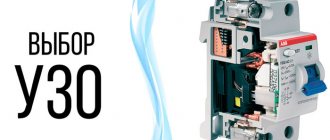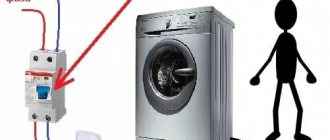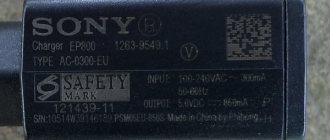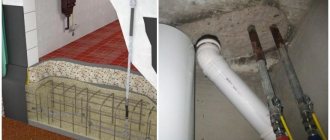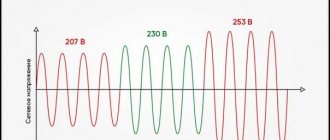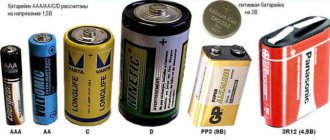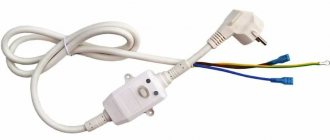If you have already decided on the choice of UPS for your boiler, the next task will be to install and connect it correctly.
By the way, you can check yourself to see if you made a catastrophic mistake when buying an uninterruptible power supply. You can learn about this from the article “5 mistakes when choosing a UPS for a gas boiler.”
What function do residual current devices perform?
Its use can save you from electric shock, prevent fire if the contacts are not of very good quality, the insulation is damaged, or there are other problems in the wiring. For this reason, there is no need to ignore the installation of an RCD.
Differential current switches (VDT) are those machines that are placed in front of the RCD, in accordance with GOST 51326.1-99. In England - RCCD's, in France - ID.
How many phases can the equipment have?
There is a single-phase ouzo or a three-phase ouzo . Everything is simple here. If the network has only one phase, then the RCD should be single-phase (1 phase and zero). In situations where the network has three phases, then, naturally, the residual current device should be used with three phases (zero and 2 phases).
You also need to know that today they mainly use three-phase networks, the power of which is 15 kW. In order to provide good protection against fire or electric shock, a three-phase protective device is connected. This is highly discouraged, due to the fact that if the RCD is turned off, all three phases are blocked, even when only one has an electricity leak. But for boilers, electric stoves, hobs and other equipment installed in private homes, it is best to use a three-phase RCD.
Why keep distance
The kitchen is the busiest area with electrical appliances.
A refrigerator, a microwave oven, an exhaust system, a dishwasher - these are a small fraction of household appliances, without which it is impossible to imagine it. Therefore, safety in this part of the apartment should come first. Electricity, gas and water supply are useful inventions, but in the hands of a hack or an irresponsible person they become the cause of fires, injuries, and accidents. To avoid such troubles when developing a kitchen design, you need to carefully consider all the details of the interior, and also carefully consider the location of sockets in relation to the gas pipe, hob, and heating appliances. Health, well-being, and sometimes even human life depend on it. The minimum distance of the socket to the pipeline or gas pipe is 50 cm.
How does an RCD work: principle of operation
The operation of the device is based on a comparison of the magnitude of electricity passing through it, in other words, the amount of electricity passing through this device to the consumer is equal to the magnitude of the current exiting through the neutral conductor of the device. As can be seen in the figure, I1 goes to the device that receives electricity, and I2 goes from it. If the electrical wiring is done correctly, there are no violations, I1 and I2 are equal to each other, nothing disrupts their operation.
Let's look at the simplest example. When a person touches a conductor (zero or phase), part of the electricity I∆n will transfer to it, which, in turn, will cause I1 not to be equal to I2, due to the fact that I1 > I2 – I∆n. The residual current device is highly sensitive to this, so it will immediately turn off, and the person will be protected from electric shock. The device should work very quickly, in a matter of seconds. The electric current, which manages to pass through the entire body in such a short time, has minimal strength, which is not fatal.
Rules for placing pipes and sockets
When laying an electrical cable, you need to take into account that it is heated by currents, and the heating device located nearby also heats the surrounding air. Therefore, it is better to avoid laying wires near gas supply and heating pipes altogether. But if it doesn’t work out, you should remember that the rules of the PUE (electrical installation rules) stipulate that the air temperature in such cases should not exceed +25˚С, therefore, in order to comply with fire safety rules, the distance for parallel installation is the distance from cables and wires to heating pipes must be at least 100 mm, and to gas pipes - 400 mm. When crossing wires with hot pipelines, the distance between them must be at least 50 mm, and with gas pipelines - at least 100 mm.
The switch and socket from the gas pipe must be located at a distance of at least 0.5 meters. This requirement is due to the fact that the gas pipeline contains flammable gas, and in an emergency, the slightest spark from an outlet or switch will cause irreparable disaster.
An outlet located close to a gas pipe can cause an emergency, since electricity is adjacent to highly flammable gas.
Varieties by rated current
The most popular are modular devices from the ABB and Schneider Electric brands. There are possible types of rated electricity, which indicates its value that can pass an infinite number of times through the device: 16, 25, 40, 63 A. Therefore, the choice of device should be based precisely on these values of rated electricity.
There is no device that could provide 100% protection against overcurrents (short circuit, network overload), and this must be understood. That is why it is important that all RCDs are supplied with a circuit breaker with a rated current of less or the same strength. This is what the rules say, but I consider it advisable to install the RCD and the machine in such a way that the device has a larger rated current.
I will try to explain such “violations” of the rules in more detail. It is known that the machine can transmit electricity from 1 norm to 1.13 for a very long time, and only for an hour - 1.13-1.45. So, for example, if both the machine and the RCD are 25 A, the device transmits electricity in the amount of 36 A (25 * 1.45) per hour. Most likely, the device will simply burn out.
The rated electricity value can be found on the front of the device.
Well-known brands produce devices with the ratings indicated above, but Chinese manufacturers can produce 32 or 50A RCDs.
Rated breaking current is the most important criterion for RCDs
This criterion shows the amount of current when the device is turned off. It is designated as I∆n (setpoint), it can be: 10, 30, 100, 300, and also 500 mA. There is no way for a person to open his hands to remove the cable when the network voltage is 30 mA or more. Therefore, it is better to opt for 10 or 30 mA devices, which will make it possible to protect yourself from possible electric shock.
Ahead on any device you can find the value of I∆n.
A 10 mA device is used to reliably protect electricity receivers in rooms where the humidity level is characterized as high (bathroom, toilet, etc.), as follows from SP 31-110-2003 (clause A.4.15). Can also be used for dishwashers and washing machines, providing electricity to bathrooms, toilets, balconies or loggias, and heated floors.
If we talk about 30 mA devices, then it is better to install them if the lines of the kitchen, bathroom, restroom or corridor are separated. Simply put, it is better to install a 10 mA RCD on another cable, which is used for a separate unit of household appliances, for example, a dishwasher. If one cable also powers an outlet in another room, then it is better to install a 30 mA RCD. In rooms, a 30 mA RCD is most often used to organize light and sockets.
The ABB company produces RCDs only for 10 mA, and such popular brands as Schneider Electric and Hager produce 25/10 mA and 16/10 mA.
Residual current devices for 100, 300, and 500 mA are fire protection type RCDs. Of course, in cases where the shock of electricity is so strong that it is fatal, it will not save, but if a fire occurs due to faulty wiring, it is capable. The installation location of the device is the beginning of the line.
In electrical networks where plug-type sockets are powered, according to the PUE (clause 7.1.79), it is better to install an RCD of 30 mA and no more. It is possible to connect several groups of lines to one device using separate safety elements.
In America, only 6 mA RCDs can be used, and in Europe - up to 30 mA. So, if the device is set to 30 mA, it is important that it operates at 15-30 mA, in other words, the protective device will trip at 50-100% setting.
There are developers who use differentiated methods to protect the washing machine and other energy consumers. So, for example, the machine is connected to a 16/10 mA device, and it itself is connected to a 40/30 mA group device.
In such a situation, even with a very slight malfunction in the operation of the machine, all automation (lighting, boiler) turns off. In most cases, it is almost impossible to determine whether one or both RCDs will turn off at once.
When an RCD is installed, in accordance with SP 31-110-2003 (clause A.4.2), when drawing up a design for electrical installations in residential and public buildings, it is important that the selectivity requirements are clearly and consistently observed. If the circuit contains two or more stages, the settings of the operating current and its time for protective shutdown devices near the power source must be at least three times greater than for the device that is near the electricity consumer.
Electrical wiring carried out in compliance with all the rules will prevent RCDs from tripping for several years.
Types of RCD triggering
According to this criterion, there are electronic and electromechanical devices. The first option will be cheaper in price, which can be explained by a cheaper production process, however, the reliability of such devices is lower. The power of the first option comes from the network, and the quality of its functioning is determined by the parameters and quality of the electrical network.
Let's look at this in more detail using a simple example. The zero phase burned out in the electrical panel on the floor of a building on several floors; accordingly, the electronic type device will turn off and be inoperative (it needs power to work). If a short circuit occurs and someone touches it, the device will not respond. Electronics may also break down, especially if the Chinese device is of poor quality.
As for the second version of devices, they can be characterized as more reliable; they are not influenced by the state of the network. It is for this reason that it is optimal to use them.
Their work is based on comparing the electricity that leaves and enters the device. The device will turn off if the electricity is unequal to the setpoint or greater than it.
These diagrams allow you to understand which version of the device: electronic or electromechanical. The operation diagram is applied on the front side of the device body.
ABB, Schneider Electric, Hager, Legrand and other well-known manufacturers produce exclusively electromechanical devices, which is why they have been able to earn a reputation as manufacturers of RCDs of the highest quality and reliability.
The following picture shows a cross-section of electronic and electromechanical devices, which makes it possible to compare them from the inside. An example of an electronic device made in China, because, as already mentioned, well-known brands produce exclusively electromechanical RCDs.
Existing types of RCDs
Electricity leakage in the network determines the existing types of devices. So, for example, when there is alternating current, RCDs of one type are switched off, while others are switched off when the current is alternating and pulsating.
AC-type RCDs will turn off when there is an instantaneous alternating current leak (lighting, convectors, refrigerator, heated floor, etc.). The icon on the front indicates AC type. This type can also be designated “AS” or two designations at once.
An A-type RCD is simultaneously sensitive to alternating and pulsating electricity leakage; it can occur instantly or slowly increase. In modern washing machines and dishwashers, PCs, TVs, microwaves and other electronically controlled household appliances, rectifiers and switching power supplies are used. There are modern household appliances that use A-type protective devices.
- designation of this type of ouzo.
It is also necessary to emphasize that the protection zone of the A-type is higher than that of the AC type, which determines their higher cost. However, if it is not possible to install an A-type RCD, it is better to at least have an AC one. This will provide at least minimal protection.
PUE 7.1.78 does not prohibit the use of devices AC (they are sensitive to alternating current leakage) and A (they react to alternating and sensitive fault currents). Examples of pulsating electricity include computer equipment, televisions, dishwashers, light sources that can be regulated, etc.
To better understand which type of RCD is optimal for a specific household appliance, you should first carefully read the instructions for its use. As a rule, manufacturers provide recommendations.
AC-type devices are prohibited from being used in Europe, only A-type RCDs. B-type RCDs are extremely rarely used in the Russian Federation. An example of a place for using these RCDs would be industrial enterprises where leaks of rectified electricity occur, etc. B-type equipment is not used in everyday life.
Connecting a wall-mounted boiler to the electrical network
Most modern wall-mounted gas boilers are equipped with sophisticated automation. It controls many processes, turning the heating boiler into an autonomous mini-boiler room, the operation of which requires virtually no intervention from the owner. Obviously, the control unit and various sensors require an electrical connection.
Double-circuit wall-mounted boilers are available in two versions: with a conventional socket and with a cable for connecting directly to the machine. In any case, they must be powered from the mains through an individual machine. If you purchased a model with a plug, then the individual socket for the gas boiler should be located next to it, but in no case under it. This is one of the safety requirements so that in the event of a coolant leak, a short circuit does not occur.
A gas boiler requires mandatory grounding. For these purposes, you can purchase a point grounding kit. It is installed in the basement or next to the house and occupies a small area of about 0.25 m².
Attention! Grounding a wall-mounted gas boiler to a heating radiator or gas supply pipe is strictly prohibited. This is a gross violation of the rules for operating gas equipment and is extremely dangerous.
Boiler automation is very sensitive to the quality of the supply voltage. If the level of the sinusoid at the input is insufficient or the shape is not ideal, the devices quickly fail. To prevent frequent breakdowns and extend the service life of the unit, it is necessary to connect voltage stabilizers for gas boilers. To avoid shutdowns of heating equipment in the event of power outages, you should additionally purchase an uninterruptible power supply.
Types of devices depending on when they are turned off
Devices, depending on the time that is maintained before they operate, exist in the following types:
- there is no holding time. The purpose of devices of this type is to perform a protective function against electric shock or fire in the event of wiring failures. RCDs of this type are the primary protection; they are most often installed on the lines of power receivers;
- fireproof or S-type. They turn off in 0.2-0.5 s. It can only protect against fire, but not against injury or electric shock. Such a device is placed near the input machine only at the beginning of the line. Provides a second degree of fire protection, connects automation in the electrical panel and protects the input cable. Selectivity is indicated by the presence of the “S” designation on the front side of the device.
Below you can see examples of a fire protection RCD for one phase at 100 mA from the manufacturer ABB and for 3 phases and 300 mA from the manufacturer Schneider Electric.
The leakage rating of an S-type RCD can range from 100 to 300 mA. They provide second degree protection. Existing installation requirements stipulate that the degree of response time delay and the electricity setting, if several RCDs are installed on the same line, for each subsequent installation exceed the previous one.
When RCDs are installed, in accordance with SP 31-110-2003 (clause A.4.2), all selectivity requirements must be strictly observed. When the RCD circuit is two- and multi-stage, devices near power sources should have a higher response time and response current setting than those located near electricity consumers.
If there is a power leak and there is no time delay, and there are two devices on the line (30 and 100 mA), they would trip together, and the most powerful RCD in the entire building would turn off the electricity. It follows that you need to choose a fire-fighting device that is installed in an outdoor electrical panel to ensure high-quality fire protection.
There are also G-type RCDs. It is similar to the one described above, but its exposure time is 0.06-0.08 s. This is a pretty rare type. Having ordered such a device, you have to wait several months for it, which causes certain inconvenience.
Power cable for an electric heating boiler: selection of cross-section and brand
In the article “Connecting an electric boiler” I touched a little on the topic of choosing the cross-section of the power cable for an electric boiler. Here I will continue this topic and tell you in more detail how to supply power to an electric heating boiler in all its parameters.
General connection rules
Let me remind you of the general rules for connecting electric boilers:
- Boilers up to 3.5 kW can be connected to the power supply via an outlet.
- Boilers up to 7 kW must be connected only through a separate circuit breaker with the installation of an RCD.
- Boilers 7–10 kW must be connected from 380 Volts, only through a separate circuit breaker.
- Boilers over 10 kW require a separate installation permit.
No wires, just cables?
The first question, which usually remains “behind the scenes,” is why you need to use a cable and not separate wires to connect an electric boiler?
In the theory of electrical installations and regulations, there are no prohibitions on using wires selected according to the cross-section and protected according to all rules to power electrical installations.
Another thing is that doing electrical wiring with wires is more difficult, or rather more inconvenient, than with a cable. Wires cannot be laid without protection. To lay them, it is imperative to use metal or electrical plastic pipes. Tightening wires into pipes requires some skills and special tools.
Unlike wires, cable lines can be laid: PUE 2.3.33: openly, in boxes or pipes, including pipes laid in floors and ceilings, ... and double floors.

